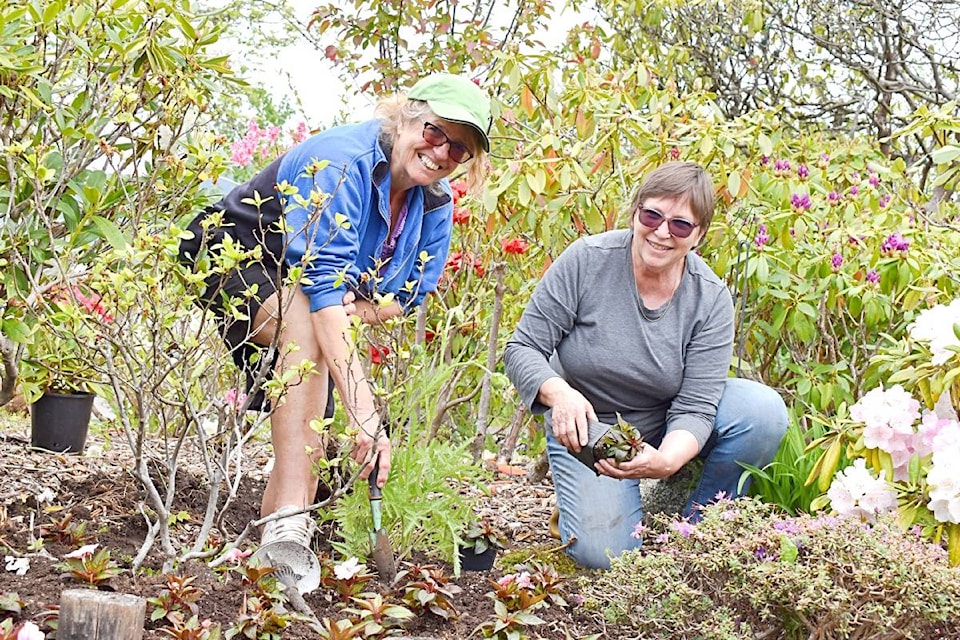Rainbow resilience and hearts of love are the floral flags designed and planted to acknowledge the community’s war on the coronavirus in the Prince Rupert Sunken Gardens this year.
The Prince Rupert Garden Club is rooted in its dedication to beautifying, year after year, the lower esplanade framed by the shale terraced garden beds and surrounding upper level of the grounds in the park.
Prince Rupert Garden Club Project Manager, Andrée Fawcett said that initially when the garden club took over the operations of the garden in 2001, 15,000 annuals were planted each year. Over the years, with more and more perennials being planted, the number of annuals is now down to 8,000.
Fawcett explained that an annual is a plant that blooms and has its life cycle in a one year period, where a perennial blooms or comes back year after year.
The design for this years garden beds was completed by Fawcett and the committee members. The flower hearts and rainbows in the gardens compliment the actions of city residents who placed the symbols of love in their windows during the pandemic.
Specific plants and flowers in the gardens are chosen to be deer durable, so there are lots of begonias, geraniums, and sunflowers, which the wildlife don’t usually eat, she said.
READ MORE: VIDEO, PHOTOS, STORY: Touring the gardens of Rupert’s best green thumbs
The garden club, which started in the early 1920’s, built a brand new green house on the property this past winter. Prince Rupert Port Authority very generously assisted with the partial costs of this project, Fawcett said, which was to assist with the teaching focus of the group.
Fawcett said, over the past couple of years the club has offered instructional seminars, not just on flowers and garden plants, but on food growth as well. The club is trying to grow the membership and attract more people by offering mentorship and educational classes, as well as the social-connection component.
The club also takes on various projects around the city with the next one planned for planting at Acropolis Manor.
While the Sunken Gardens are located on provincial land and the spring plants are funded through the government, the majority of planting labour is volunteered by club members. More than 120 man-hours have been freely given in just the past week for the gardens spring clean up. The club itself, which is non profit, relies on fundraising to cover its costs.
At some point, in the next year or two, the garden club will be celebrating its 100 anniversary. The exact date is unknown as records dating back that far are unclear.
“We know that groups of people got together in the late teens (of the past century) to start a group for the community gardens…We don’t have a specific date. We’re not officially sure…We will pick a year.”
Fawcett said, in commemoration of the clubs jubilee, she would love to see a gazebo built on the Sunken Garden grounds for the community to use and enjoy. She even has the perfect spot picked out. While she is extremely proud of her team of volunteers and gives them special praise for their outstanding efforts, fundraising for this project will take a lot of effort for the committee and money they just don’t have, she said.
The Prince Rupert Garden Club has been providing the project management for the Sunken Gardens for the past 20 years. when they first started it was because the grounds had become a concern for many residents, as it had been used for different purposes and lacked care.
The rock terrace, which make the garden beds, are historically the walls of the court house foundation, built pre-1914. Construction on the grounds was halted before WWI. After the war, the court house was completed in 1922, but was moved forward 35 feet to its current location. The re-location left behind a large crater and already built foundations. Relief workers during the 1920s and ’30s started to build the gardens. During WWII, the original foundation walls and tunnels were used for munitions storage and equipment transportation to the docks at the water front, Fawcett said.
READ MORE: Growing in full sun at the Prince Rupert Plant and Flower Market
There was extensive ground work required to prepare the land for garden usage when the Garden Club took over. The shovels were put to digging in 2003. It took two years to clean up before the club could eventually plant some trees and annuals.
“Mother Nature was taking over so there was all kinds of (debris) in here. So we started from the very basic. We rebuilt the pathway, we brought in machines, so we did a lot,” said Fawcett, including the completion of the not so pretty stuff, like property drainage.
“We all had the plan that we would do five years, and then …take a look, see how we’re feeling and then continue on. Well, we obviously are still here,” Fawcett said.
“Because of COVID-19 we have a lot of brand new gardeners. We want to help keep the excitement fresh and assist the new gardeners to grow with their skills,” Fawcett said.
K-J Millar | Journalist
Send K-J email
Like the The Northern View on Facebook
Follow us on Twitter
